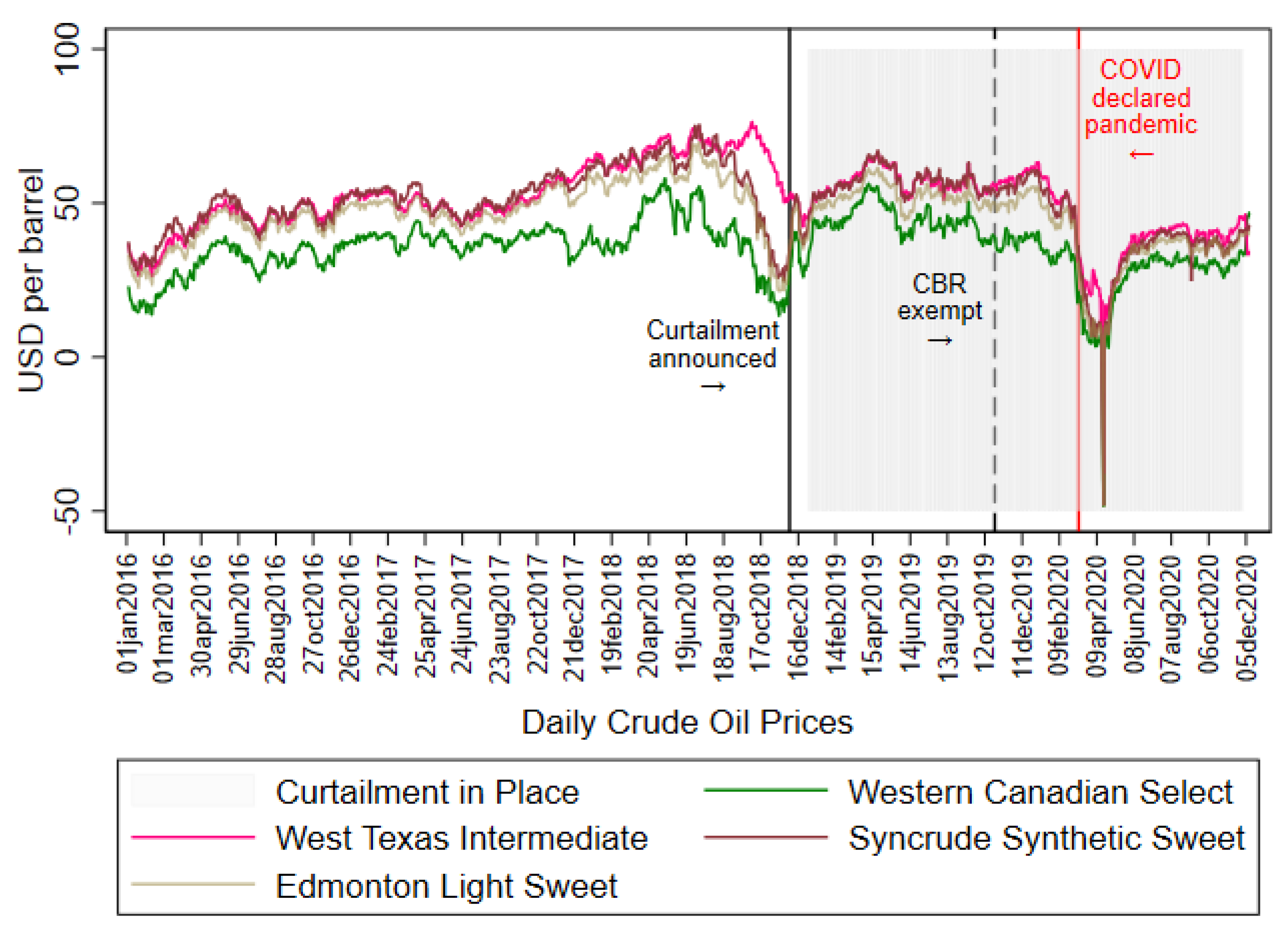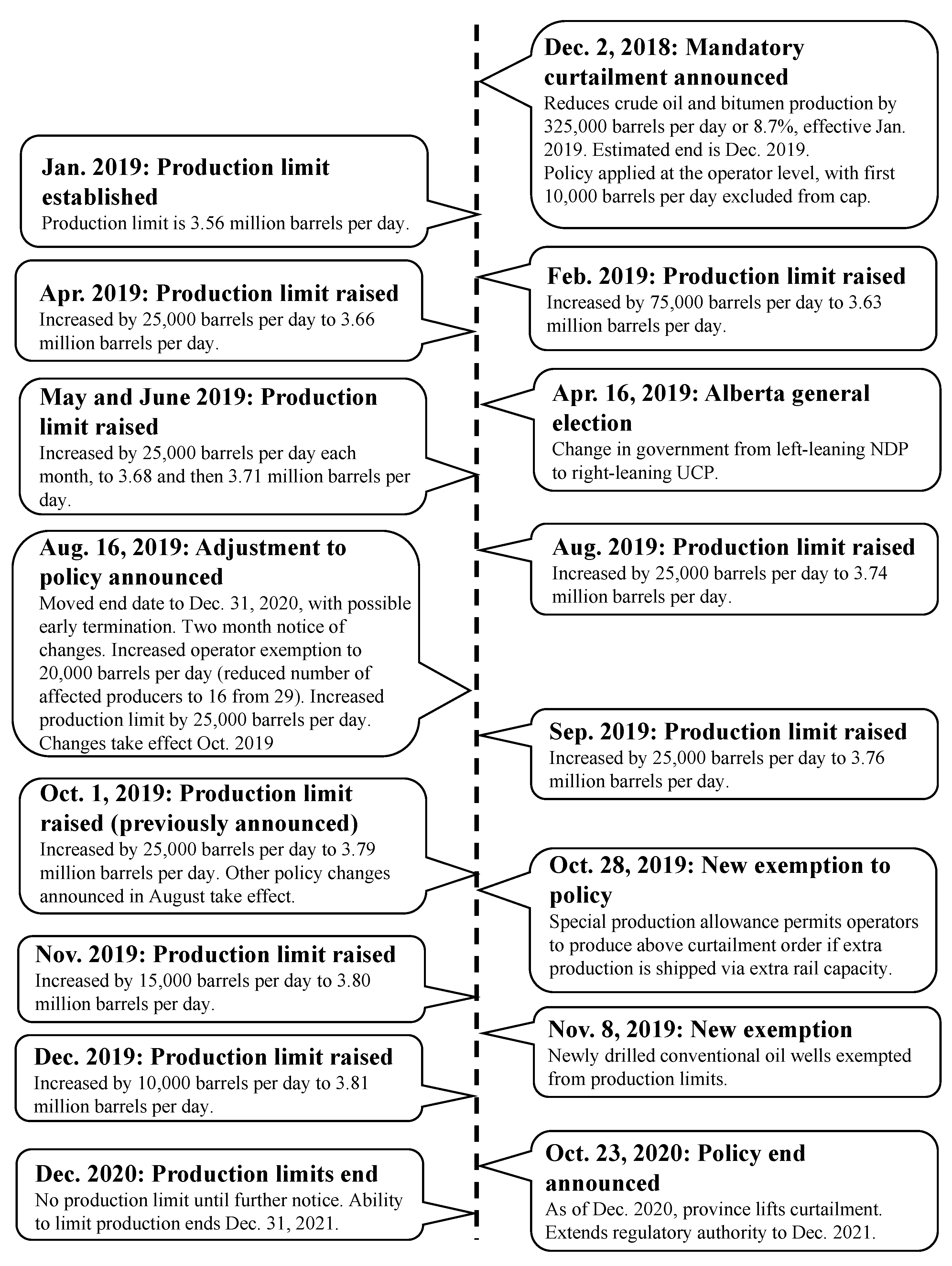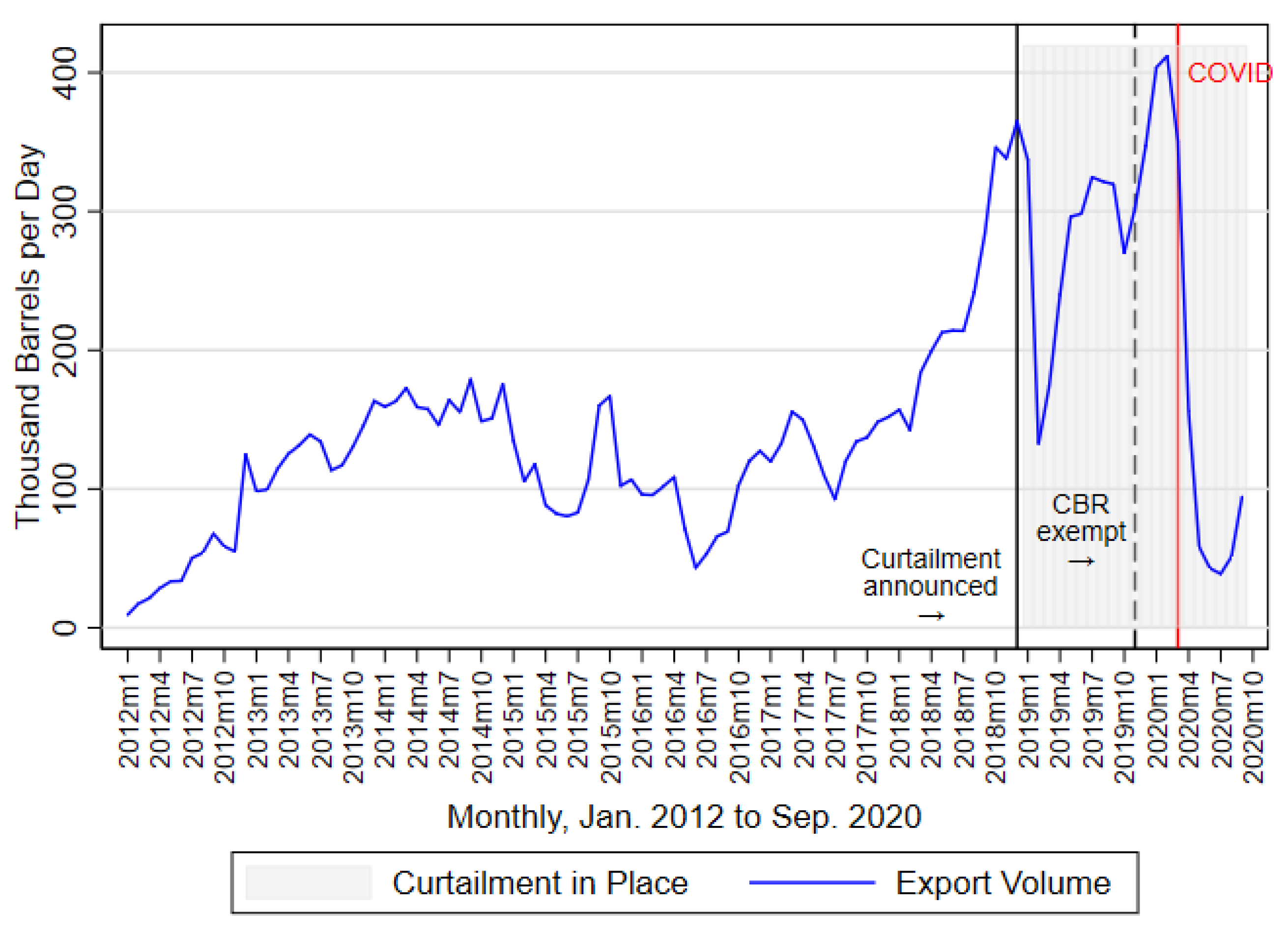3.1. Conceptual Framework
Alberta’s curtailment policy was designed to reduce the WCS-WTI price differential and, in turn, transfer surplus from refiners of crude oil to producers. It accomplished this by limiting the quantity supplied, creating artificial scarcity, and leading to an increase in the price of Alberta’s heavy oil and bitumen. We use a partial equilibrium framework, as set out in Gardner [
29], to quantify the economic magnitude of the surplus transfer, both in total and at the margin, demonstrating how these values depend on supply and demand elasticities.
We illustrate the intuition for the transfer in
Figure 6.
Figure 6 shows a blue demand curve and red supply schedule for Albertan oil (for the purpose of this exercise, we abstract from quality differences in the different types of Albertan oil and focus on heavy oil). Prior to production curtailment, the market price and quantity are given by
and
. Price,
p, can be thought of as the WCS and
Q as heavy oil and bitumen. The curtailment policy is a production control that limits output to
, with higher prices paid by consumers as the consequence:
increases to
.
Two effects are apparent in
Figure 6. First, the objective of the policy was to increase the price received by producers, thereby transferring surplus from consumers to producers. At
, producers receive an additional
per barrel relative to the pre-curtailment equilibrium. This is shown along the vertical axis. Region
a illustrates the total value of the resulting transfer from consumers (refineries) to producers. It equals the increase in price,
multiplied by the restricted output,
. In order to obtain area
a, however, producers forego region
c, the producer surplus on the restricted supply,
. If the size of
a is greater than the size of
c, as it is in
Figure 6, Albertan oil producers are better off. Refiners, in turn, as demanders of crude bitumen, must pay a higher price for their feedstock and are unambiguously worse off.
A second implication of
Figure 6 is that the production restrictions distort the market, creating deadweight loss. The deadweight loss, represented by area
, arises because a smaller quantity of heavy oil and bitumen are supplied than would be the case without curtailment. This deadweight loss only arises if the equilibrium is given by
and
. A prospective argument, one argued by selected industry participants, is that pipeline bottlenecks distorted this equilibrium, and an alternative, inefficient equilibrium would have been obtained in the absence of the curtailment. Our opinion is that this is not the correct way to view this problem. Pipelines are not the only means of transportation. Rail and trucks are also used to ship crude and bitumen. Granted, they have higher costs and may be uneconomic (i.e., marginal costs increase with production), but they were viable modes of transport. Further, oil is storable, so placing barrels in storage is another option. A vital role of markets is to send signals to producers and consumers with respect to various demand and supply options. Prior to the curtailment, government intervention did not distort the market signals. Therefore,
and
is the appropriate “no policy” counterfactual. At the market level, then, a trade-off exists. Increases in producer surplus are offset by increases in overall deadweight loss. We measure this trade-off, both in absolute value and at the margin, as the deadweight loss per marginal dollar transferred.
Figure 6, finally, demonstrates how the government’s curtailment decision is akin to a monopolist’s problem (i.e., the Lerner condition). Another trade-off exists between the transfer to producers, area
a, and the foregone producer surplus, region
c. An “optimal” policy, one that seeks to maximize producer surplus, would choose a production level that maximized area
a. The Government of Alberta controls quantity to determine the regional, industry-wide price effectively. (We note that the Government of Alberta is not a disinterested or neutral party here, though the specifics of its incentives are beyond the scope of this exercise.)
To quantify the economic magnitudes of
Figure 6, we need to measure the displacement of the equilibrium resulting from the curtailment. The sizes of areas
a,
b, and
c depend on the slopes of the supply and demand curves. Following Gardner [
29], we define consumer and producer surpluses as
where
is the (inverse) demand function, reflecting the price paid by consumers, and
is (inverse) supply function, representing the marginal cost of producers.
The curtailment restricts output such that , where is output under the production controls (i.e., 8.7% reduction on 1 January 2019) and is equilibrium output under a counterfactual scenario where there is no intervention in the market. It also means that (or that ) as the price paid by consumers at output exceeds producers’ willingness to sell at that output.
By implementing production controls, the curtailment transfers surplus from consumers to producers. Define a function,
T, that characterizes how
and
change with the policy variable
.
T sketches a locus of producer and consumer surpluses, the slope of which gives the trade-off between
and
for different values of
. It is the slope of
T that is our primary statistic of interest because it represents the marginal market-wide deadweight loss per dollar transferred to producers. Applying the implicit function theorem to
, one obtains: Alternatively, the slope of the surplus transfer curve can be found by inverting the
expression, Equation (
1), to obtain an expression for
, the policy choice of the government. This inverted expression is then substituted into the formula for
, Equation (
2), to obtain producer surplus as a function of consumer surplus.
where the (inverse) demand function facing the consumer,
, is used to determine the price (i.e., the production controls artificially increase the price per barrel).
Assuming functional forms for the (inverse) supply and demand equations allows us to add some structure to Equation (
3). We start with linear functions. The inverse demand function is
and the inverse supply function is
. Then, Equation (
3) can then be written as
where
is the slope of the supply function and
is the slope of the demand function. Assuming isoelastic functional forms gives an equivalent expression:
where
is the price elasticity of demand and
is the price elasticity of supply.
Equation (
4) shows the marginal change in producer surplus from an increase in consumer surplus. We expect and find that this ratio is negative and less than one. It is negative because the Government of Alberta reduced consumer surplus to increase producer surplus. The change in consumer surplus, the denominator on the left-hand side of Equation (
3), declines as producer surplus, the numerator, increases. It is less than one because there is a deadweight loss arising from a
$1 transfer from consumers to producers. Not every dollar taken from refiners makes it to producers. This expression enables us to calculate the marginal efficiency cost imposed by the curtailment on the consumers of Alberta oil. This depends on the rates of change of the supply and demand functions. Briefly, increasing the supply elasticity shrinks the market-level deadweight loss per dollar transferred as the slope of the transfer curve approaches
. Increasing the (absolute value) of the elasticity of demand (
is a negative number), in contrast, increases the marginal deadweight loss per dollar transferred, shrinking the ratio. The more responsive demand is, the more challenging it is to transfer surplus from consumers. Likewise, a flatter, or more elastic, (inverse) supply curve means that the foregone producer surplus (area
c in
Figure 6) is smaller, thereby increasing the ratio of the producer to consumer surplus.
Our empirical analysis recovers needed parameters and elasticities by assuming that demand is given by either a linear or negative exponential functional form, while supply is always assumed to be linear. Using elasticities from the literature, we also explore the sensitivity of the marginal deadweight loss calculations with isoelastic functional forms. The next section describes how we select the elasticities for our calculations.













